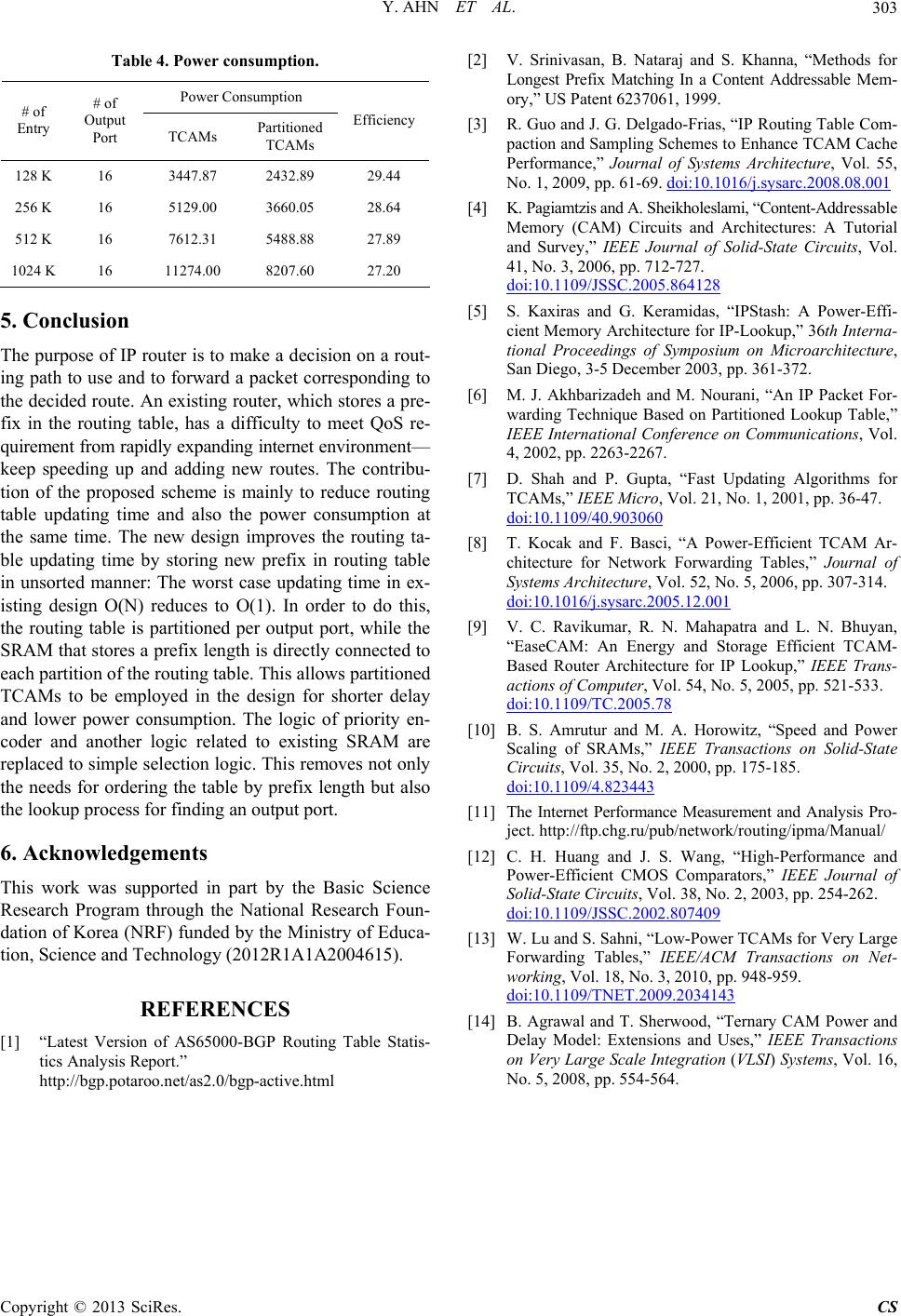
Y. AHN ET AL.
Copyright © 2013 SciRes. CS
303
Table 4. Power consumption.
Power Consumption
# of
Entry
# of
Output
Port TCAMs Partitioned
TCAMs
Efficiency
128 K 16 3447.87 2432.89 29.44
256 K 16 5129.00 3660.05 28.64
512 K 16 7612.31 5488.88 27.89
1024 K 16 11274.00 8207.60 27.20
5. Conclusion
The purpose of IP router is to make a decision on a rout-
ing path to use and to forward a packet corresponding to
the decided route. An existing router, which stores a pre-
fix in the routing table, has a difficulty to meet QoS re-
quirement from rapidly expanding internet environmen t—
keep speeding up and adding new routes. The contribu-
tion of the proposed scheme is mainly to reduce routing
table updating time and also the power consumption at
the same time. The new design improves the routing ta-
ble updating time by storing new prefix in routing table
in unsorted manner: The worst case updating time in ex-
isting design O(N) reduces to O(1). In order to do this,
the routing table is partitioned per output port, while the
SRAM that stores a prefix length is directly connected to
each partition of the routing table. This allows partitioned
TCAMs to be employed in the design for shorter delay
and lower power consumption. The logic of priority en-
coder and another logic related to existing SRAM are
replaced to simple selection logic. This removes not only
the needs for ordering the table by prefix length but also
the lookup process for finding an output port.
6. Acknowledgements
This work was supported in part by the Basic Science
Research Program through the National Research Foun-
dation of Korea (NRF) funded by the Ministry of Educa-
tion, Science an d Technology (2012R1A1A2004615).
REFERENCES
[1] “Latest Version of AS65000-BGP Routing Table Statis-
tics Analysis Report.”
http://bgp.potaroo.net/as2.0/bgp-active.html
[2] V. Srinivasan, B. Nataraj and S. Khanna, “Methods for
Longest Prefix Matching In a Content Addressable Mem-
ory,” US Patent 6237061, 1999.
[3] R. Guo and J. G. Delgado-Frias, “IP Routing Table Com-
paction and Sampling Schemes to Enhance TCAM Cache
Performance,” Journal of Systems Architecture, Vol. 55,
No. 1, 2009, pp. 61-69. doi:10.1016/j.sysarc.2008.08.001
[4] K. Pagiamtzis and A. Sheikholeslami, “Content-Addressable
Memory (CAM) Circuits and Architectures: A Tutorial
and Survey,” IEEE Journal of Solid-State Circuits, Vol.
41, No. 3, 2006, pp. 712-727.
doi:10.1109/JSSC.2005.864128
[5] S. Kaxiras and G. Keramidas, “IPStash: A Power-Effi-
cient Memory Architecture for IP-Lookup,” 36th Interna-
tional Proceedings of Symposium on Microarchitecture,
San Diego, 3-5 December 2003, pp. 361-372.
[6] M. J. Akhbarizadeh and M. Nourani, “An IP Packet For-
warding Technique Based on Partitioned Lookup Table,”
IEEE International Conference on Communications, Vol.
4, 2002, pp. 2263-2267.
[7] D. Shah and P. Gupta, “Fast Updating Algorithms for
TCAMs,” IEEE Micro, Vol. 21, No. 1, 2001, pp. 36-47.
doi:10.1109/40.903060
[8] T. Kocak and F. Basci, “A Power-Efficient TCAM Ar-
chitecture for Network Forwarding Tables,” Journal of
Systems Architecture, Vol. 52, No. 5, 2006, pp. 307-314.
doi:10.1016/j.sysarc.2005.12.001
[9] V. C. Ravikumar, R. N. Mahapatra and L. N. Bhuyan,
“EaseCAM: An Energy and Storage Efficient TCAM-
Based Router Architecture for IP Lookup,” IEEE Trans-
actions of Computer, Vol. 54, No. 5, 2005, pp. 521-533.
doi:10.1109/TC.2005.78
[10] B. S. Amrutur and M. A. Horowitz, “Speed and Power
Scaling of SRAMs,” IEEE Transactions on Solid-State
Circuits, Vol. 35, No. 2, 2000, pp. 175-185.
doi:10.1109/4.823443
[11] The Internet Performance Measurement and Analysis Pro-
ject. http://ftp.chg.ru/pub/network/routing/ipma/Manual/
[12] C. H. Huang and J. S. Wang, “High-Performance and
Power-Efficient CMOS Comparators,” IEEE Journal of
Solid-State Circuits, Vol. 38, No. 2, 2003, pp. 254-262.
doi:10.1109/JSSC.2002.807409
[13] W. Lu and S. Sahni, “Low-Power TCAMs for Very Large
Forwarding Tables,” IEEE/ACM Transactions on Net-
working, Vol. 18, No. 3, 2010, pp. 948-959.
doi:10.1109/TNET.2009.2034143
[14] B. Agrawal and T. Sherwood, “Ternary CAM Power and
Delay Model: Extensions and Uses,” IEEE Transactions
on Very Large Scale Integration (VLSI) Systems, Vol. 16,
No. 5, 2008, pp. 554-564.